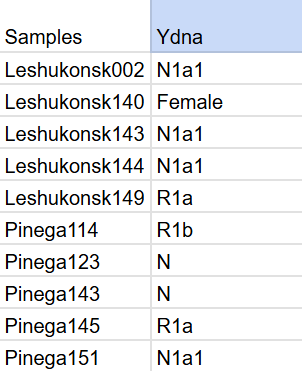
Leshukonsk + Pinega Russians 10 raw DNA files .HO dataset
North of Arkhangelsk, where the Pinega River threads through endless spruce and the Mezen winds bite, live the Pomors of Pinega and Leshukonsk—descendants of medieval Novgorod settlers who fused river life with the old Finno-Ugric North. In these villages the sea-borne Pomor spirit turned inland: men ferried timber and tar on flat-bottomed boats, trapped along winter trails, and traded deep into Komi country; women kept the hearth in towering log izbas and painted utensils with bold Mezen motifs—red deer, prancing horses, and sun signs that feel as ancient as the taiga itself.
Their story is one of crossroads. With the Komi, they shared winter trade routes, borrowed words, crafts, and even kin—Orthodox faith binding communities where mixed marriages did happen, bringing Komi weaving patterns and reindeer goods into Pomor homes. From the Vepsians to the southwest came echoes too: boatbuilding tricks for shallow rivers, woodcarving styles, and a Finnic cadence that still hums under local dialects.
At 65 latitude north, just seventy miles shy of the Arctic Circle, Leshukonsk and Pinega live under extreme skies. In December, the sun barely brushes the horizon for four or five hours a day, while in June the nights never come at all. These cycles carved deep into Pomor culture. The long dark winters turned villages inward, giving rise to rich storytelling traditions, epic byliny recitations, and long evenings of embroidery, woodcarving, and song by the stove. Winter also became the season of weddings and communal feasts, when farm and river work lay dormant.
Come summer, when daylight never ended, Pomor life flipped outward—endless fishing trips on the Pinega and Mezen, timber floating, bee-keeping, and river trade that could stretch far into the night without need of lanterns. The very rhythm of Pomor faith and folklore mirrors this cycle: winter tales of spirits and protectors of the dark forest, summer rituals of light, water, and fertility. In many ways, the northern sky itself became the metronome of Pomor identity—marking when to gather, when to wander, and how to weave endurance and celebration into life on the edge of the Arctic.
For this video, I gathered the raw genomes of 10 pomors from Pinega and Leshukonsk from Reichlab’s AADR + .HO dataset. I ran them through my Trait predictor for DNA analysis to gather statistics on their health and phenotypes.
